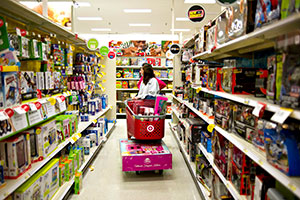Consumers Help GDP Contract Less Than Last Estimated

The world’s largest economy shrank in the first quarter, just not as much as previously estimated, with the help of a bigger gain in consumer spending.
Gross domestic product fell at a 0.2% annualized rate, revised from a previously reported 0.7% drop, data from Commerce Department showed June 24 in Washington. That matched the median forecast of 76 economists surveyed by Bloomberg News.
The harsh winter weather and port delays that slowed growth at the start of the year have given way to increases in consumer spending and housing, bolstering Federal Reserve projections that the setback was temporary. Still, pockets of weakness remain as lower oil prices continue to hinder investment in the energy industry and a firm dollar restrains global sales.
“What we are seeing here does validate the story that the first-quarter weakness was transitory,” said Michael Feroli, chief U.S. economist at JPMorgan Chase & Co. in New York, who correctly forecast GDP. “The consumer is coming back to overall decent growth.”
Economists’ estimates ranged from a decline of 0.5% to an increase of 0.4%. The economy grew at a 2.2% pace from October through December.
“Part of this weakness was likely the result of transitory factors,” Fed Chair Janet Yellen said in a press conference last week after policymakers met to discuss the outlook for monetary policy. “Despite the soft first quarter, the fundamentals underlying household spending appear favorable, and consumer sentiment remains solid.”
Central bankers signaled a pickup in the economy will keep them on track to raise interest rates this year, though subsequent increases are likely to be more gradual than anticipated earlier.
This was the third GDP reading for the quarter, with future updates coming once a year in July as more detailed data become available.
When revisions are issued on July 30, the Bureau of Economic Analysis has said it will address the so-called residual seasonality that some economists have said has caused first-quarter data to be persistently weak. That has sparked a debate about the extent of the bias, with the Fed Board and regional Fed banks jumping into the fray.
First-quarter growth has underperformed the rest of the year by about 1.6 percentage points to 1.7 points on average, based on a range of results from those who believe the figures are faulty.
The first estimate of second-quarter GDP is also scheduled for July 30. The economy will expand at a 2.5% rate from April through June and average 3% growth in the last half of the year, according to the median projection of economists surveyed by Bloomberg from June 5 to June 10.
Among the details of the report, household consumption grew at a 2.1% annualized rate last quarter, revised up from an initial estimate of 1.8%. The increase reflected larger outlays on food and transportation.
The median forecast in the Bloomberg survey projected consumer spending would be revised up to 1.9%, after a 4.4% gain in the fourth quarter.
Spending has held up as the job market improves. After-tax income adjusted for inflation grew at a 5.3% pace in the first three months of the year, the biggest gain since the end of 2012. Because earnings increased more than spending, the saving rate rose to 5.4% from 4.7% at the end of 2014.
Recent data indicate household purchases have picked up this quarter. Retail sales advanced 1.2% in May, reflecting broad-based gains from car dealers to clothing outlets and department stores, according to Commerce Department figures. That followed a 0.2% gain in April.
Auto sales remain a bright spot for consumer spending and factory production. Cars and light trucks sold at a 17.7 million annualized rate in May, the strongest pace since July 2005, data from Ward’s Automotive Group showed.
In addition to consumer spending, bigger gains in inventories and home building, and a smaller decline in nonresidential structures also helped lift GDP in the first quarter.
While the cutbacks in oil exploration and drilling in the wake of plunging crude prices hurt the first quarter, economists anticipate the worst may be over as crude prices have steadied.
Business investment is stabilizing, data showed on June 23. Bookings for non-military capital goods excluding aircraft — a proxy for future corporate spending — rose in May after dropping the prior month.
Trade remained a sore spot, with the gap between exports and imports swelling. The deficit subtracted 1.9%age points from growth, the most since 1985.
Residential construction increased at a 6.5% annualized rate, more than previously projected. The pickup in the housing market indicates the contribution may expand. New home sales climbed in May, helping lift the combined purchases of new and existing dwellings to a 5.9 million annualized rate, the highest since 2007.




